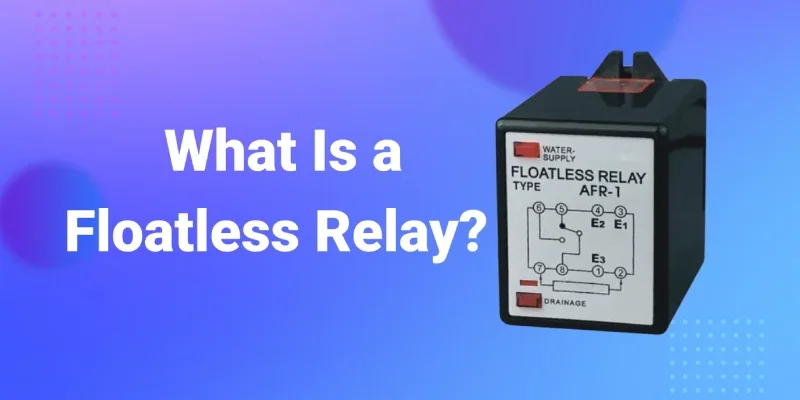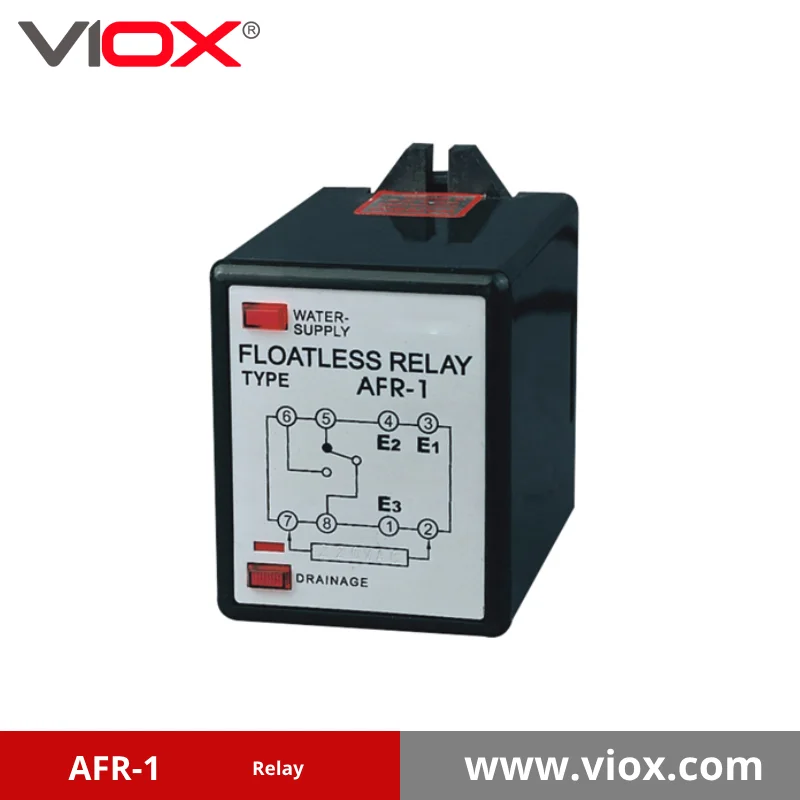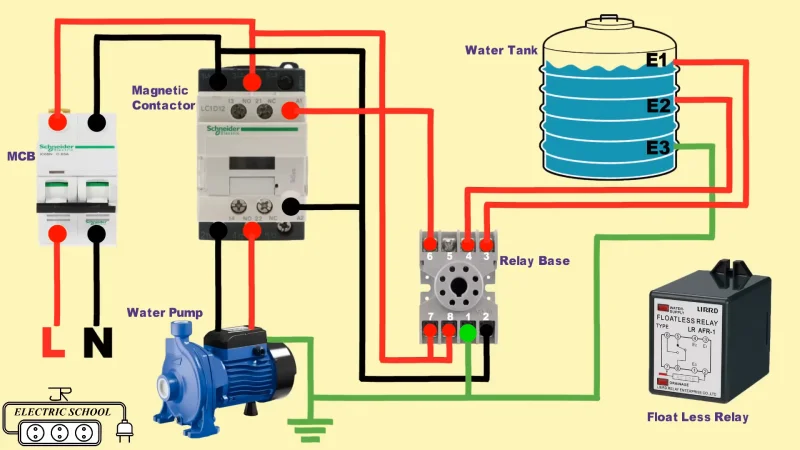Bezplováková relé jsou pokročilá elektronická zařízení používaná k regulaci hladiny kapalin, která ve srovnání s tradičními mechanickými plovákovými spínači nabízejí delší životnost, rychlejší odezvu a vyšší přesnost. Tato zařízení využívají vodivé elektrody nebo kapacitní senzory k detekci hladiny kapalin, což je ideální pro různé aplikace v průmyslových odvětvích, jako je úprava vody, zpracování chemikálií a výroba potravin.
Bezplovákový provoz relé
Bezplováková relé pracují na principu elektrické vodivosti a detekují a kontrolují hladinu kapaliny. Systém se obvykle skládá ze tří elektrod: E1 (horní mez), E2 (dolní mez) a E3 (společná nebo zem). Když hladina kapaliny stoupne a dotkne se E1, uzavře se elektrický obvod mezi E1 a E3, což způsobí, že relé sepne energii a přepne své kontakty.
Relé je vybaveno samočinným udržovacím obvodem E2, který udržuje obvod i v případě, že hladina kapaliny klesne pod E1, a zabraňuje tak rychlému zapínání a vypínání v důsledku vlnění hladiny. Když hladina kapaliny klesne pod E2, obvod se rozpojí a relé se odpojí od napětí. Tento jednoduchý, ale účinný mechanismus umožňuje přesné ovládání čerpadel nebo ventilů na základě hladiny kapaliny, přičemž aplikace sahají od řízení zásobování vodou až po řízení průmyslových procesů.
Výhody bezplovákových relé
Bezplováková relé mají oproti tradičním mechanickým plovákovým spínačům několik klíčových výhod. Jejich konstrukce, která eliminuje pohyblivé části, vede k výrazně delší provozní životnosti a nižší poruchovosti. Tento elektronický přístup k detekci hladiny kapalin poskytuje přesnější řízení, což je zásadní pro aplikace v chemickém zpracování a úpravě vody. Kromě toho se tato zařízení mohou pochlubit rychlejší reakcí na změny hladiny kapaliny, což zvyšuje celkovou účinnost systému. Kompaktní objem a zásuvná sestava některých modelů usnadňují instalaci a výměnu, což přispívá ke snadnější údržbě a modernizaci systému.
Typy bezplovákových relé a jejich vlastnosti
Bezplováková relé se vyrábějí v různých typech, z nichž každý je určen pro specifické aplikace a prostředí. Mezi nejběžnější typy patří:
- Modely pro všeobecné použití: Tato univerzální relé pracují se standardním napětím (110 V, 220 V, 380 V AC) a jsou vhodná pro širokou škálu aplikací regulace hladiny kapalin.
- Modely s vysokou citlivostí: Tato relé jsou určena pro použití s kapalinami s nízkou vodivostí a mohou detekovat odpor až 70 kΩ, takže jsou ideální pro systémy s čištěnou vodou.
- Modely na dlouhé vzdálenosti: Tato relé jsou schopna pracovat s kabely dlouhými až 4 km a jsou ideální pro vzdálené monitorování a ovládání ve velkých průmyslových zařízeních.
- Dvouvodičové systémy: Tyto zjednodušené modely snižují složitost instalace a náklady díky použití pouze dvou vodičů pro napájení i signalizaci.
Funkce jednotlivých modelů se liší, ale často zahrnují nastavitelnou citlivost, LED indikátory provozního stavu a kompatibilitu s různými typy elektrod. Některé pokročilé modely nabízejí více režimů řízení, například automatické řízení přívodu a odvodu vody, což zvyšuje jejich univerzálnost v průmyslových aplikacích.
Schéma zapojení bezplovákového relé
Zapojení bezplovákových relé je kritickým aspektem implementace těchto zařízení do systémů řízení hladiny kapalin. Konfigurace zapojení obvykle zahrnuje připojení relé ke zdroji napájení, elektrodám a ovládanému zařízení, jako jsou čerpadla nebo ventily. U standardních modelů zapojení zahrnuje přípojky pro zdroj napájení (obvykle 110 V, 220 V nebo 380 V AC), elektrodové svorky (E1, E2, E3) a výstupní kontakty (normálně otevřené a normálně uzavřené).
- Napájecí svorky se připojují k příslušnému zdroji napětí.
- Svorky elektrod se připojují k vodivým sondám v kapalině.
- Výstupní svorky se připojují k ovládanému zařízení nebo stykači.
Pro aplikace zásobování vodou se cívka elektromagnetického spínače obvykle připojuje k příslušné svorce, zatímco pro aplikace odvodnění se připojuje k jiné určené svorce. Pro bezpečnost a přesný provoz je velmi důležité svorku E3 řádně uzemnit. Některé pokročilé modely nabízejí zjednodušené dvouvodičové konfigurace, které snižují složitost instalace. Při zapojování bezplovákových relé je nezbytné dodržovat pokyny výrobce a místní elektrické předpisy, aby byl zajištěn bezpečný a spolehlivý provoz.
Prozkoumejte více na Youtube
Průmyslové aplikace bezplovákových relé
Bezplováková relé nacházejí široké uplatnění v různých průmyslových odvětvích díky své spolehlivosti a účinnosti. V chemickém průmyslu hlídají hladiny ve skladovacích nádržích a zajišťují tak bezpečné výrobní procesy. V úpravnách vody se tato zařízení používají k ovládání zařízení na čištění odpadních vod a k efektivnímu řízení vodních zdrojů. Potravinářské závody využívají bezplováková relé k udržování správné hladiny surovin, čímž zajišťují kontrolu kvality. Ve farmaceutickém odvětví hrají tato relé klíčovou roli při udržování bezpečné hladiny v reaktorech během výroby.
- Vhodné pro vodovodní a kanalizační systémy.
- Používá se v aplikacích pro všeobecné použití a v rozváděčích.
- Ideální pro kontrolu hladiny jakékoli vodivé kapaliny.
- Zvyšuje bezpečnost a efektivitu průmyslových procesů.
Omezení bezplovákových relé
I přes své četné výhody mají bezplováková relé určitá omezení, která by uživatelé měli vzít v úvahu. Tato zařízení vyžadují ke své funkci nepřetržité napájení, což může být problematické při výpadku proudu. Navíc jsou vhodná pouze pro vodivé kapaliny, což omezuje jejich použití s nevodivými látkami, jako jsou oleje nebo destilovaná voda.
- Vyšší počáteční náklady ve srovnání s tradičními plovákovými spínači.
- Možnost falešných údajů ve vysoce vodivých nebo kontaminovaných kapalinách.
- Může vyžadovat pravidelnou údržbu elektrod, aby se zabránilo jejich nánosům nebo korozi.
- Citlivost na elektromagnetické rušení v některých průmyslových prostředích.
Řešení běžných problémů s bezplovákovými relé
Bezplováková relé jsou sice obecně spolehlivá, ale mohou se vyskytnout problémy, které ovlivňují jejich výkon. Mezi běžné problémy patří selhání zapnutí nebo vypnutí, nepravidelná činnost a odpor kontaktů. Při řešení těchto problémů zkontrolujte následující skutečnosti:
- Zkontrolujte, zda nejsou elektrodové spoje zkratované nebo uvolněné.
- Vyčistěte elektrody, abyste odstranili veškeré nánosy, které mohou narušovat vodivost.
- Ověřte správné nastavení citlivosti pro konkrétní monitorovanou kapalinu.
- Ujistěte se, že je relé dimenzováno na zátěž, kterou spíná, aby se zabránilo přehřátí.
- Zkontrolujte, zda nejsou přítomny faktory prostředí, jako je prach nebo vlhkost, které mohou ovlivnit výkon.
Pokud problémy přetrvávají, simulujte změny úrovně zkratováním elektrod, abyste zjistili, zda je problém v samotném relé nebo v systému elektrod. Pravidelná údržba a správná instalace podle pokynů výrobce může výskyt těchto problémů výrazně omezit.
Hlavní rozdíly oproti elektromechanickým relé
Bezplováková relé mají v aplikacích řízení hladiny kapalin několik klíčových výhod oproti tradičním elektromechanickým relé:
- Delší životnost: Díky absenci pohyblivých částí vydrží bezplaváková relé podstatně více spínacích cyklů, často až 100krát déle než elektromechanická relé.
- Rychlejší odezva: Bezplováková relé poskytují rychlejší reakční dobu na změny hladiny kapaliny, obvykle reagují v řádu milisekund ve srovnání s 5-15 ms u elektromechanických relé.
- Nižší spotřeba energie: Bezplováková relé spotřebovávají až o 75% méně energie než jejich elektromechanické protějšky, což zvyšuje energetickou účinnost.
- Tichý provoz: Absence mechanických součástí eliminuje cvakavý hluk spojený s elektromechanickými relé.
- Odolnost vůči faktorům prostředí: Bezplováková relé jsou méně náchylná na vibrace, nárazy a magnetické rušení, takže jsou spolehlivější v náročných průmyslových podmínkách.
Bezplováková relé však mají obecně vyšší počáteční náklady a jsou omezena na použití s vodivými kapalinami, zatímco elektromechanická relé mohou zvládnout širší škálu aplikací a vyšší proudové zatížení. Volba mezi nimi závisí na konkrétních požadavcích aplikace, podmínkách prostředí a rozpočtových omezeních.
Doporučené postupy pro instalaci bezplovákových relé
Při instalaci bezplovákových relé je třeba dodržovat osvědčené postupy, které zajistí optimální výkon a dlouhou životnost:
- Namontujte reléovou jednotku na suché, bezprašné místo, aby byla chráněna před vlivy okolního prostředí.
- Použijte vhodný držák elektrod a elektrody pro konkrétní aplikaci s ohledem na faktory, jako je vodivost kapaliny a materiál nádrže.
- Zajistěte správné rozestupy mezi elektrodami, abyste zabránili falešným údajům. Vzdálenost mezi elektrodami E1 a E2 určuje rozsah kontrolované hladiny vody.
- V zájmu bezpečnosti a přesnosti provozu elektrodu E3 řádně uzemněte.
- Pro použití na velké vzdálenosti používejte stíněné vodiče nebo zvažte modely pro velké vzdálenosti, abyste minimalizovali rušení.
- Nastavení citlivosti upravte podle vodivosti kapaliny. Pro kapaliny s nízkou vodivostí použijte modely s vysokou citlivostí.
- Pravidelně čistěte elektrody, abyste zabránili tvorbě nánosů, které by mohly narušit vodivost a způsobit poruchu.
Dodržováním těchto postupů můžete maximalizovat spolehlivost a účinnost svého bezplavákového reléového systému, snížit potřebu údržby a prodloužit jeho provozní životnost.




